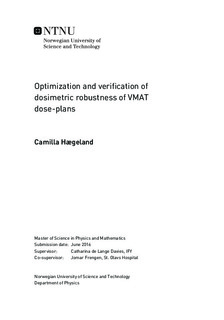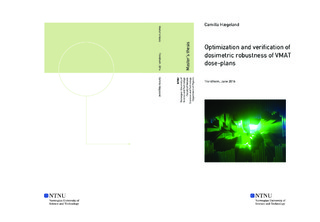| dc.description.abstract | Radiation therapy has for several years played an important role in the curative management of patients with early stage disease and also in the palliation of symptoms associated with advanced or metastatic disease. Organs at risk (OAR) and normal healthy tissue located around the tumor may receive a high radiation dose that can cause serious side effects and altered quality of life. A highly conformal and precise dose delivery is therefore very important for a successful treatment. Volumetric modulated arc therapy (VMAT) is a relative new radiation technique that has become a conventional method used in radiotherapy. VMAT is arc-based, in which the gantry speed, multileaf collimator (MLC) position, and dose rate vary continuously during dose delivery. In this thesis the dosimetric predictability of VMAT plans has been studied.
A Delta4 phantom from ScandiDos was the main detector used for the measurements of dose
distributions and verification values of treatment plans. A diamond detector and a gafchromic EBT film were also used in measurements of small field sizes and the penumbra region. A verification depends on how well the delivered dose and its spatial coordinates correspond to a calculated value. For the Delta4 phantom the γ-index was used as a comparison index for the verification, including both the dose deviation (DD) and the spatial deviation (DTA, distance to agreement). The γ-index analyzes the deviation between the calculated and measured dose distribution. The criteria to the γ-index was set to 3 % / 3 mm, allowing a maximum DD of ± 3 % and maximum DTA of ± 3 mm.
The robustness against introduced offsets were tested for two different optimization sequences for eight clinical treatment plans. The two sequences had a simultaneous and a sequential sequence, where the arrangement of added object functions/constraints to the plan differed. The introduced offsets were both physical MLC offset, and simulated offsets of geometrical parameters in the linac model, simulated in the doseplanning system.
In RayStation treatment planning system (TPS) different scripts were made to extract information from treatment plans in the TPS, and to create plans with specific MLC behavior. The extracted MLC information was used in numerical analyzes of differences in the MLC positions, comparing different optimization sequences (sequential, simultaneous, and the original clinical optimization) for the eight clinical treatment cases. The extracted information was related to the complexity of a treatment plan, and which of the optimization sequence that may result in a less complex and more robust plan. Plans with specific MLC behavior were used to study MLC characteristics and uncertainties regarding the dynamic MLC movements. Specific plans were created for measurements of the gravitational effect on the MLC leaves, small field dosimetry, and MLC motion.
In this study MLC characteristics and the robustness of VMAT plans have been studied, trying
to get a better understanding of the dosimetric predictability of VMAT plans. A robustness-index has been suggested, based on the results in this thesis, giving an estimate of the robustness and complexity of a treatment plan. | |

